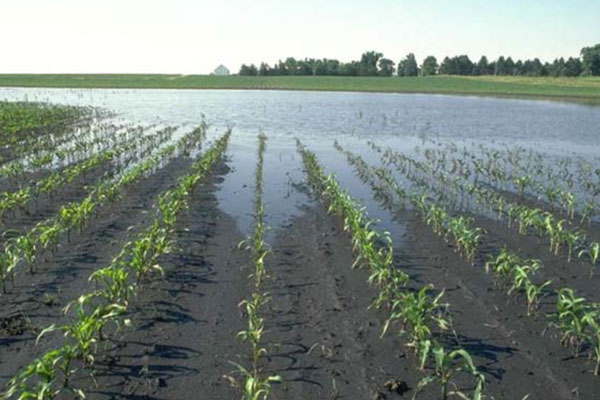Taking an environmentally sensitive approach to pest management
Corn and Soybean Survival after Flooding
Published: May 30, 2019

The extreme 2019 rainfall events have created record, or near record, river levels across many locations in the state. Many rivers and creeks across a wide geography of Missouri have put numerous corn fields under water. This article discusses the impact on crops planted in fields that are now flooded or saturated. Of the many factors that determine how well a seedling crop will tolerate flooding, below are the most important to consider when evaluating flooded corn and soybean fields:
- Duration of the flooding
- Temperature during the flood
- Rate of drying and conditions just after the flooding event
Research in flooded soils has shown that the oxygen concentration drops rapidly and is nearly depleted in 24 to 48 hours. However, the moderate movement of water allows some oxygen to get to the plants, and damage is not as severe. Oxygen is critical for the plant to perform basic functions including respiration, water uptake and root growth. Without oxygen, the growing point cannot respire and critical functions are greatly impaired. Water-logging also leads to accumulations of compounds like CO2, which are toxic to plants in high concentrations.

Young corn can survive flooded conditions lasting for about 2 days under warm temperatures (at or above mid-70s°F) to 4 days under cooler temperatures (at or below mid-60s°F). Survivability is also influenced by how much of the plant was submerged and how quickly the water recedes. Corn plants that survived flooded conditions should show new leaf development within 3 to 5 days after water recedes.
Generally, soybeans tolerate flooding better and can survive 48 hours under water quite well. Flooding for 4 days or more can significantly reduce stands, vigor, and yield. Flooded and saturated conditions also restrict root development, thereby reducing the crop's ability to take up water and nutrients and tolerate drought stress later in the season.
Growth stage is a factor in survivability due to flooding. Larger plants require more oxygen to stay alive. However, smaller plants are more likely to become completely submerged and often remain submerged for longer periods.
As mentioned earlier, temperature makes a difference. If temperatures are abnormally warm during the flooding period, the crop survival period may be reduced by 50% or more. Conversely, if temperatures are cool the survival of the submerged crop increases because its metabolic processes are slowed down. Flooding from this time of year on, with the typically warm temperatures, is certainly working against survivability.
Cool, wet soils are ideal for disease development. These conditions are not only optimal for some soil pathogens, but delay plant growth and development. Delayed development can allow plants to be more susceptible to damage by soil-borne diseases that attack seeds and seedlings. Although it is warmer now, a pathogen may have started in the plant when we had cooler temperatures.
Seed treatments have been shown to help, but typically only provide protection for a couple of weeks. If cool, wet conditions persist longer than two to three weeks, crop stands can be at risk. Pythium is a common disease that can cause damage to seedlings of soybean or corn. Phytophthora can damage soybean seedlings or start infections in the early summer that may develop and kill soybean plants later in the summer. For corn, a healthy radicle root and coleoptile should be white to cream color. Examine seedlings for disease, looking for rotted or discolored seedlings, roots and damping off symptoms.
Check out the link to the recent MU croppest newsletter article for more information: Stand loss due to seedling disease.
It is important to note that the impacts of saturated and ponded areas of fields is similar in the effect on seedling corn and soybean plants as those fields that experience flooded conditions.
Replant Decisions:
Deciding whether or not to replant can be a tough decision but there are some key factors to keep in mind. The effectiveness of replanting will be affected by the combination of planting date and changing environmental conditions. It is important to make the decision based on economics and not emotions.
For further information, check out the MU Integrated Pest Management article: Evaluating Corn Stands for Possible Replant.
In the case of flooded fields, once water recedes, growth will resume approximately within 3 to 5 days. During this time the evaluation of corn stand and plant survivability should be made. Conduct stand counts and refer to MU guide 4091: "Corn and Soybean Replant Decisions" at the following link: http://extension.missouri.edu/p/G4091 for more information.
If corn is to be chemically killed, refer to the recent croppest Article from Dr. Kevin Bradley: Herbicide Options for Killing Failed Corn Stands.
Subscribe to receive similar articles sent directly to your inbox!
REVISED: February 21, 2017